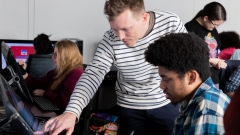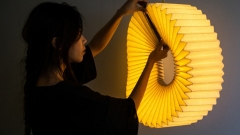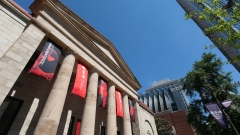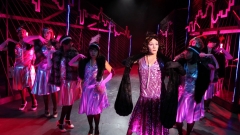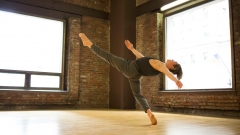UArts Awards 2023 Creative Research & Innovation Grants
April 12, 2023
University of the Arts has announced the recipients of the 2023 Grants for Creative Research and Innovation program, providing funding to 12 innovative projects led by UArts faculty and staff.
Through funding provided by the President’s Fund for Excellence, the Grants for Creative Research and Innovation program is able to disburse over $68,000 to realize the 12 projects. The 2023 grant cycle saw a 44% increase in submitted proposals. The President’s Fund for Excellence continues to grow, thanks to support from private donors.
The program’s second round of funding is allowing UArts staff and faculty members to explore identity and history through video, audio and performances; build DIY vehicles; develop several multimedia performances; and creative and immersive virtual reality narrative.
The grant recipients will begin to conduct research, travel and execute their projects immediately, with many resulting performances, installations, production periods and travel taking place over the summer and into early fall.
The staff and faculty selected to receive grants this year are Anthony Guido, Kevin Merinsky, María Jimena Paz, Arabia Richardson, Chris Rodgers, Priyanjali Sen, Mikhail Sergeev, Cynthia Veloric, Emily Wexler, Lauren Whearty, Rebecca Wright and Uwazi Zamani. Below is an overview of the staff and faculty projects that have received funding from the President’s Fund for Excellence.
Overview of funded projects
Anthony Guido: DIY Urban Cargo E-Bike production
Anthony Guido, associate professor at the School of Design, will build a fully functional, affordable DIY cargo e-bike to help spark interest in the new UArts Product Design program and both produce and demonstrate important design concepts and practices for Guido’s courses.
Guido’s build process draws on open source DIY e-bike plans from Danish firm NK55 and will involve fabricating, documenting, using and presenting actual examples of progressive, eco-minded design. Furthermore, the production will be directly incorporated into Guido’s coursework, specifically Design for Sustainability and the fabrication shop-based course Exhibition Materials and Methods. The experience and documentation developed during the build process will serve as a model for future Product Design (both MDes and BFA levels) hands-on studio learning projects and will potentially be repurposed into design workshops for high school students seeking enrollment at UArts.
Arabia Richardson: ‘And Now We’re Live’ dance and historiography project
Arabia Richardson, adjunct assistant professor at the School of Dance, will be undertaking a continuation of her MFA thesis, titled “And Now We’re Live,” which is an expansive project encompassing historiographical delving and exploratory dance. Richardson will travel to Goshen, Alabama, to continue in-depth work on assembling family history. While there, she will visit local libraries and government buildings to comb through county residential records, meet with people who knew of her family before they ventured up north; and interviewing, archiving and finding ways to help dance move us closer to the next answer.
“I consider this to be a lifelong project, tracing my histories and bringing my discoveries back to my living relatives, becoming the family's historian and archivist,” Richardson says of the research. “Being present in a space such as Goshen will allow me to work with the gravity of Blackness, time traveling into the past and making new rhythms from the body and causing dynamic shifts in space using gestures, emphasizing tones and facial expressions from interviewing … continuing to find the archival traces through movement, documentation, collecting and sharing. Through this process, I hope to enlighten my family, as well other members of the Black community, of the importance of familial archivism.”
Richardson will travel during the summer and complete the project in August.
Chris M. Rodgers: ‘Stillness is the Move’ solo exhibition
Chris Rodgers, UArts’ ceramic technician, is presenting Stillness is the Move, a solo exhibition hosted by the Clay Studio in Philadelphia’s Kensington neighborhood, in July 2023. The Creative Research and Innovation Grant will support the cost of materials and kiln firings necessary to realize Rodgers’ project. He cites the exhibition as an important opportunity to demonstrate the development of his personal creative practice and experience as a resident artist at the Clay Studio, furthering his career as a working artist.
Rodgers aims to create 10 to 12 sculptures, including a delicate spherical piece and a classical bust. The sphere will be adorned with a relief of small cast ceramic feathers covered with silver leaf, and the classical bust will be broken, then refired to be rejoined.
Beyond any personal professional goals, Rodgers hopes that the exhibition can work to connect the greater UArts and the Clay Studio communities. He notes that his exhibition can act as an introduction to the Clay Studio for UArts students, leading to their exploration of other creative outlets in Philadelphia and expansion of their own practices.
Cynthia Haveson Veloric: COCE conference presentation
Critical Studies adjunct associate professor Cynthia Veloric will be attending and presenting at the International Environmental Communication Association’s Conference on Communication and Environment (COCE). The COCE will address planetary ecology and our fractured environment, with sessions devoted to sustainability, pedagogy and education, policy and governance, social media and technology, consumption and agriculture, science media and journalism, and animal voices—to name only a few areas of focus!
“The conference will catalyze new ways of seeing and communicating the planetary crisis and thus will enhance my abilities as a university lecturer and freelance curator,” Veloric says. “This opportunity, in turn, would complement my teaching of environmental art at the university. My presence at the conference will increase my visibility as an academic and bring the UArts name to a new discipline.”
Veloric’s paper and presentation is titled “Pollution Pods: Synesthetic Space as Environmental Communication,” which Veloric will present in June.
Emily Wexler: ‘Birdsong’ multimedia solo performance
Emily Wexler, adjunct associate professor in the School of Dance, is developing Birdsong, a multilayer, multimedia solo performance that will be choreographed and performed by Wexler and incorporate video projects of LOVESONG, a trio of films with a cast of 10 dancers. Throughout the choreographic work and performances, Wexler is exploring “the repetitive experience of trauma and the ways in which grief vibrates within us.” Leading motifs in the performance include erosion, repetition, and digging—all choreographic concepts that Wexler will explore in movement scores, which will include some established movement phrases derived from personal memories.
The performance itself will include a pair of very loud industrial fans on the highest setting which will be in the performance space, closely facing Wexler as the audience enters and serving as a conceptual element, an atmospheric sound source that interacts with the score and as a choreographic component. Wexler will also be collaborating with sculptor Jena Gilbert-Merrill to create a large, raw-clay vessel for the performance.
Birdsong will be performed in May 2023.
Kevin Merinsky: ‘Betaverse’ interactive virtual-reality film
Creative Technology Specialist Kevin Merinsky is working on realizing Betaverse, an interactive virtual-reality film that asks participants to question our ability to determine fact from fiction when technology can be used to fabricate whole worlds right before our eyes.
Merinsky describes Betaverse as a project that aims to foreshadow what disinformation could evolve into as digital environments become more immersive. “Best described as an interactive virtual reality narrative experience, Betaverse will rely on user interactions to change a participant’s experience in unintended ways and create a shifting narrative designed to keep its user engaged,” he elaborates.
Participants will be placed into a three-dimensional scene and launched into a narrative experience that borrows from an undecided historical event. Each character or element they interact with will be recorded and used to gauge the user’s interest and/or bias toward a particular direction in the narrative. At the conclusion of a scene, Betaverse will dynamically compile the next chapter of the narrative, based on what it knows about the user, making it harder to be exposed to an alternative viewpoint as presented by characters in the film. Upon completion, participants will be shown a visual representation of their story arc and how it deviates from what actually occurred per our historical understanding.
Merinsky will have a functioning prototype of Betaverse completed in September 2023.
Lauren Ann Whearty: untitled solo show
Adjunct associate professor of fine arts Lauren Whearty will use the grant to fund the production of a body of work for a commercial gallery solo exhibition at Philadelphia’s Gross McCleaf Gallery.
Whearty’s work is focused on still life paintings. She uses the genre to make connections among aesthetics, world views and values. “Still Life painting speaks through our shared histories and projects aspirations into our future through the process of world building,” Whearty says. “It observes and critiques how we live and see and engages viewers to look more closely at the world around them.”
Whearty will complete the body of work for the exhibition by June 2023, to then be installed during the last week of June for a July show. Whearty says that the exhibition is a transformative opportunity for her studio practice and her career: “Having this platform will allow me to gain publicity, develop new relationships and most importantly, create a cohesive and ambitious body of new work.”
María Jimena Paz: ‘Conversaciones’ (working title): Conversations with Latine/x immigrant migrant dance artists
Jimena Paz, assistant professor in the School of Dance, will be interviewing artists who were born, raised and partially socialized in other countries/cultures in Latin America before migrating to the U.S.
“This presents a different perspective from notions of reclaiming cultural heritage from past generations,” Paz says of the interviews. “It is about the present, not about the past. In this particular case, the other cultures are alive in different Spanish-based native languages, the materiality of the body and bodily expressions—not only running like deep water, but also easily surfacing and overflowing.”
Paz will conduct interviews from March through June and will then transition to editing, writing and translating during her residency at the Emily Harvey Foundation in Italy during June and July. The interviews will yield a book and a podcast that Paz will present in September 2023 at the NOT Festival in New York City.
In preparation for this project, Paz is immersing herself remotely and in person in the study of cultural biology in Matriztica, Chile, a school founded by renowned biologist Humberto Maturana and Ximena Dávila, that is also known as the School of Thought of the Southern Hemisphere. She will also be studying the Quechua language and culture through the Folklore department at the University of Buenos Aires in Argentina. Paz says that “going back to study in my own language and culture with students from different places within Latin America will allow me to learn in community as I reflect on my own cultural roots.”
Mikhail Yu. Sergeev: ‘Crucifixion in Art: From Church Frescoes to Modern Painting’
Mikhail Sergeev, adjunct professor in the Critical Studies program, will complete the writing and publication of his book manuscript, provisionally titled Crucifixion: From Church Frescoes to Modern Painting. Taking a scholarly historical and comparative approach, Sergeev advances his thesis that the 20th century produced a distinctive way of portraying the Crucifixion. Namely, depictions of the Crucifixion during the 20th century yielded a universal symbol of redemption through righteous suffering. It becomes a cultural prism through which artists judge their contemporary society.
Sergeev argues that “the central event in Christian history … [remains] widespread in modern times, especially in an apparently secular and frequently atheistic 20th century. Contemporary Crucifixion paintings tend to de-emphasize the religious content and self-identify with the body on the cross. In addition, they exhibit a much greater variety and complexity.”
With first and second proofs printed and proofread by June, Sergeev expects the book to be published by M-Graphics Publishers over the summer, since he has already secured a contract with the Boston–based publisher.
Priyanjali Sen: Book Research and Short Film
Visiting Professor in Film and Media Studies Priyanjali Sen is pursuing a film history and archival research project that builds on and expands her doctoral thesis, with the Creative Research and Innovation Grant enabling the groundwork for and production of two new scholarly chapters for her in-progress book, titled The Literary Poetics of Bengali Cinema (1922–2022): History, Sensibility and Cosmopolitan Consciousness.
Sen will conduct research at the National Film Archive of India, Pune; the National Library, Kolkata; and four film societies in West Bengal (Federation of Film Societies of India – Eastern Region, Cine Central, Behrampore Film Society, and North Calcutta Film Society) that have all played a significant role in preserving, circulating and generating discourses around Bengali-language cinema in India.
One proposed chapter will focus on specific silent films that were produced during the colonial era under the regulation of British colonial policies, censorship and Cinematographic Acts. The second proposed chapter will engage with the major transformation that occurred in the Bengali film industry and film culture in the decade following the Naxalite Movement (1967), when violent peasant uprisings, along the lines of China’s Maoism, subverted the prevailing ideologies that were catering to elitist/bourgeois audiences.
Besides the overarching goal of writing two book chapters for the monograph that Sen intends to publish in the next couple of years, she will also produce a short film that will document the research process and historiography component of this project. Additionally, as a faculty ambassador to the Diversity, Equity, Inclusion and Accessibility (DEIA) Committee, Sen intends to give a talk for DEIA about displacing dominant ideas while navigating the archives during the fall 2023 semester.
Rebecca Sonia Wright: ‘OTHER ORBITS’ installation play
Rebecca Wright, adjunct assistant professor in the Ira Brind School of Theater Arts, will produce OTHER ORBITS, a large-scale installation play about community, evolution and survival through the lens of camp science fiction. The play unfolds in two spaces simultaneously complementary governing bodies in the science fiction world-building of OTHER ORBITS, between which audience members are invited to move freely, choosing for themselves what to watch and how to engage with the piece. Per Wright’s proposal, the installation set design is immersive and otherworldly and transports audiences to an alien environment, while prioritizing accessibility as a core value of the piece. OTHER ORBITS will strive to accommodate every kind of body and mobility, welcoming all audience members to “come, go, sit or get down with the performance in the consensual manner of their choice … [Audience members] can walk directly from a delicate interspecies negotiation between an alien Walrus and a talking Blackberry in the Chambers to a stately consultation in the form of social dance between a sentient Mushroom and a Mutant Pig in the Dance Hall.”
Wright has written OTHER ORBITS to unfold on a distant planet, where a group of wildly diverse non-human characters assemble at an All-Planet Council Meeting. “Like us, they find themselves in a historical moment when the actions of some are threatening the survival of many, and they will need to reimagine their entire social system in order to prevent massive ecological disaster,” Wright says. “Mutant mammals, talking plantlife and sentient machines must work together across the barriers of their varied lifespans, needs, sizes and communication methods to ensure the flourishing of all.”
The production will begin rehearsing in June 2023 and will premiere in July 2023 at Standby Studios in Philadelphia’s Kensington neighborhood.
Uwazi Zamani: ‘hooded: a hymn for the hidden’
Uwazi Zamani, artist in residence in the School of Dance, will create a multidisciplinary art and performance installation that uses text, voice and the epistolary to explore the intersections of police violence, queerness and Black boyhood. Titled “hooded: a hymn for the hidden,” the performance installation will examine how narratives of Black masculinity and Black queerness are simultaneously shaped in urban centers like Dallas, Houston and Philadelphia.
This work utilizes singing, movement, improvised sound score and visual media to “situate a hood as a recurring metaphor; one that signifies racism and the accompanying moral perception of Blackness in America” Zamani says. “In this work, I draw on Fred Moten’s notion of enclosure—a psychological entrapment caused by social precarity. This work questions how Black men navigate enclosures that frame them as reductive, noncomplex categories instead of plural and emotionally complex beings.”
The performance will have dancers responding to improvised audio loops, a primary vocalist and visual elements. Collaborators will join rehearsals and give feedback on the work in progress. For the month of April, dancers will repeat this process with audio loops recorded from previous sessions and the vocalist will improvise
Zamani will put grant funding toward lighting, sound equipment, costumes and compensating artists, as well as expanding the scope of research for this project. The finalized presentation of “hooded” will take place on Saturday, April 22.
About UArts’ Creative Research & Innovation Grant
The Creative Research and Innovation grants are made possible through the President’s Fund for Excellence, which continues to grow through the generous support from the university’s private donors.
The 2023 round of grants was evaluated and awarded by a committee of UArts faculty and staff comprising Director of Exhibitions Management & Head Preparator at the Philadelphia Art Alliance Michael Ciervo, Photography program director Jennifer Greenburg, Creative Writing;s interim program director Steven Kleinman, Associate professor at the School of Music Paul Schuette, associate professor at the Ira Brind School Fadi Skeiker and associate professor at the School of Dance Katie Swords Thurman. The selection process was facilitated by Director for Special Projects Raúl Romero.

